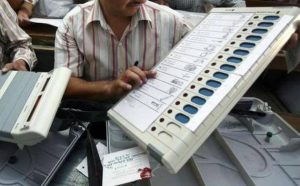
Some Facts That Raises Concerns Over Election Commission And EVMs
New Delhi: The series of Right to Information request have pulled up many threads in the Election Commission’s acquisition and use of EVMs or Electronic Voting Machines. Reports of large inconsistencies in the records of the machines which were acquired by the poll body to mysterious gaps in transportation logs and inexplicable revisions in the specifications of the units, information requests filed by a Mumbai-based RTI activist Manoranjan S Roy have presented a deeply worrying picture for the important election instrument for which India has relied upon for almost nearly three decades.

EVMs have been in use in our country since 1989. The machine comprises of a Balloting Unit, Control Unit and most recently introduced Voter Verifiable Paper Audit Train or VVPAT. These machines are manufactured only by two government-run companies – Electronics Corp of India Ltd or ECIL in Hyderabad and Bharat Electronics Ltd or BEL in Bengaluru.
Mr Roy’s queries has disclosed that from 1989-90 till May 15, 2017, the Election Commission had purchased more than 10 lakh Bus and 9.28 lakh CUs from BEL and another 10.14 lakh Bus and 9.34 lakh CUs are from ECIL. A query was done to the Law Ministry, in which it showed that the government in 2016-17 had received information about the purchase of at least 13.95 lakh Bus and 9.3 lakh CUs.

According to the details provided by Mr Roy, the figures provided by these two manufacturing units go against the figures which were provided by the Election Commission on the number of EVMs received.
When questions were posed about payments too, major discrepancies came out in the figures from 2006-07 to 2016-17. Against the Election Commission’s disclosure of “actual expenditure” of about Rs. 536 crore on voting machines, the BEL clarification had said it received from the body a payment of around Rs. 652 crore – a difference of over Rs. 116 crore.
The queries also displayed irregularities in the transportation if the EVMs. “In many instances, the transportation details are at complete variance with the purported capacity of the trucks vis-a-vis the EVM dimensions and the carrying load of the containers that are disclosed,” Mr Roy said.
“According to the standard calculations, a 32x8x8 feet container can accommodate 199 BUs or 261 CUs, and a 20x8x8 feet container can take 124 BUs or 163 CUs, but BEL says it has dispatched between 320 to 400 units per container. Were extra machines dispatched to EC? If so, what happened to them,” asked Mr Roy.
On the question of voter and candidate’s capacity of the voting machines, the figures provided point to seemingly random decisions taken by the manufacturers. “Between 1989 and 2000, the ECIL EVMs capacity was 64 candidates and voter capacity 3,902. It was modified in 2014-15 to accept 384 candidates but only for 2,000 voters. In 2014-15, its EVM’s capacity was for 60 candidates and 8,000 voters. But the capacity of VVPAT EVMs was a mere 1,500 voters,” said Mr Roy.
You May Also Read: India’s 10th Defence Expo Starts Near Chennai, National And International Firms Participate